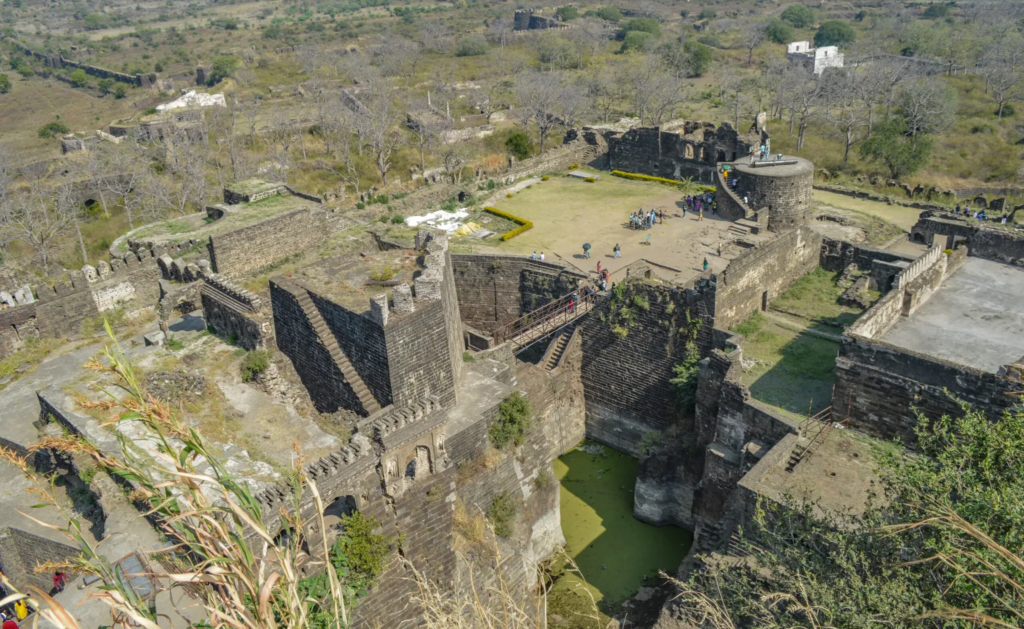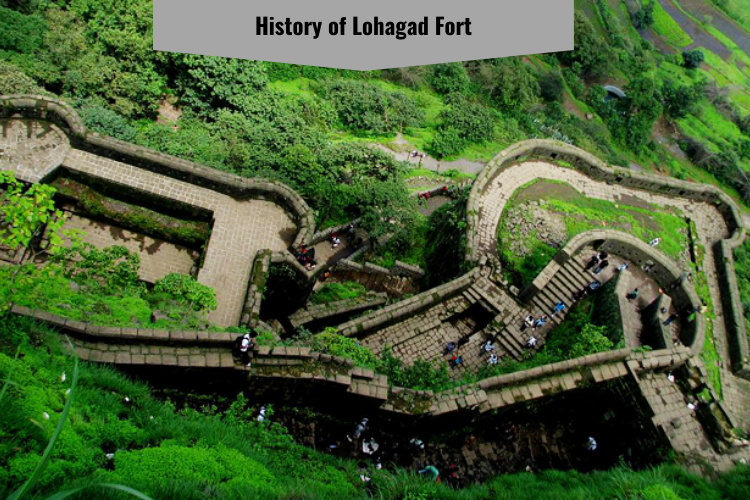Daulatabad is a medieval age fort city in Aurangabad district of Maharashtra. The fort appears on a 200 metres high conical granite hilltop and looks very attractive from a distance. Daulatabad fort complex represents impressive architecture, military engineering, town planning and water management systems. Daulatabad fort had probably been the strategic fort of most importance in entire Deccan region during medieval era. Early history of Daulatabad fort dates back to 12th century CE but the hillfort has human footprints since 100 BCE. Therefore Daulatabad fort has always remained an interesting topic for tourists and history explorers.
The most important medieval age fort city of Deccan now oversees the Aurangabad-Ellora highway, merely 16 kilometers north-west from Aurangabad. Daultabad was formerly known as Devagiri. The belief of Lord Shiva staying around the hill was the reason behind the name of Devagiri. Spanning over an area of nearly 100 hectares, the town is entirely surrounded by fort walls. Daulatabad or former Devagiri (or, Deogiri) was earlier located on the caravan route. Probably why Devagiri had always got strategic importance over the centuries.
Devagiri fort contains 12 rock cut caves which takes the history further back to 100 BCE or even older. Some of the cave carvings illustrate the niches of Jain Tirthankara. It certainly confirms that region had the influence of Jainism during post Mauryan era. Few remains of ancient Hindu and Jain temples also exist and are quite notable.
The Archaeological Survey of India now protects the fort city.
History of Daulatabad fort (Devagiri)
The Yadavas, the famous medieval dynasty of Maharashtra ruled from Devagiri. Yadava king Bhillama-V had founded Devagiri in 1187 shifted his capital from Sinnar, Nasik. The early history of Devagiri fort is rich in Yadavas dominance until Alauddin Khilji annexed Devagiri in 1296 and finally in 1308. Alauddin however only had turned Yadava king Ramachandra as his vassal.
Muhammad bin Tughlaq shifted his capital of Delhi Sultanate to Devagiri in 1327 CE. Controlling administration of southern state were becoming too difficult for him. He renamed the city of Devagiri to Daulatabad as it got him immense wealth from the Yadava kings. The word Daulatabad itself means the ‘adobe of wealth’. Sultan Tughlaq had also minted coins at Daulatabad which is mentioned as his second capital. History of Daulatabad fort therefore had reached the peak during the period. However, he shifted his capital back to Delhi in 1335 CE, to handle the rebels of northern and eastern India.

Bahamani dynasty was one of the vassals of Tughlaq who had revolted. They successfully established their empire at Daulatabad in 1347. Bahamani rule (1347-1499) was indeed a very important phase in the history of Daulatabad or Devagiri fort. They added several structures to the existing fortification. Nizam Shahi dynasty (Ahmednagar Sultanate) established in Daulatabad in 1499.
The Mughals, after long siege of four months, captured the fort around 1632-33. Prince Aurangzeb built Chini Mahal, the VIP jail here. He imprisoned Nizam Shahi prince Abul Hasan Tana Shah of Hyderabad here. After 1683, Aurangzeb shifted permanently to Aurangabad. He was mostly living in his own built Quila-e-Ark. But spent a significant time at Daulatabad fort to supervise his campaigns against the Marathas.
After Aurangzeb died in 1707, Maratha empire rule established at Deccan. But Daulatabad was soon taken over by the Nizams in 1724. The Nizams thereafter continued ruling the region until independence of India in 1947.
Architecture and major structures
Devagiri fort, built on 200 meters conical hill, is itself an extraordinary representation of ancient fort architectures. The Yadavas had further cut the bottom side slopes of the hill, leaving at least 50 meters vertical rocks each side of the hill. Such natural defense made the fort invincible to canons of any strength. Single entry or exit ways made the job more difficult for the enemies.

A moat surrounds the western part of Daultabad fort that strenghthens the protection system of Daulatabad fort. The moat once had crocodiles making it more difficult was it to pass through the moat and then the vertical rock base. Daulatabad fort also had several false doors to confuse the moving in enemy. In short, complex arrangement of entryways, curved walls, false doors made the fort unbeatable.

Main structures
Daulatabad fort architecture includes quite a few important structures. Some of them have however bow turned into ruins. Chand Minar and Chini Mahal are still bearing the legacies of the Muslim supremacy those once dominated the Indian subcontinents. However, the 12 rock cut caves of 100 BCE also approves the privilege of Buddhism and Jainism 21 centuries back.
Defense strutures
The entrance or exit scheme had always played crucial role to the fort’s defense. Daulatabad city had a three layered supreme quality defense system – namely Ambarkot, Mahakot and Kalakot.
Ambarkot had formed the first line of defence consisting of a 14 km long wall, with 45 bastions and 9 gates. The entire city of Daulatabad was residing within the periphery of Ambarkot. Mahakot, the next line of defense consited of 5 km long fortification with 4 layers of enclosure walls and 54 bastions. Kalakot, the lats layer of defense, appears at the foot of the hill. The rock-cut moat forms the defense of Kalakot section, encircling the western side.

The way to the fort is through a dark, dangerous tunnel called Andheri. The defending army would pour hot water or oil on the invading army passing through it. Small openings on the tunnel walls would also confuse the invaders and fall straight into the moat. In addition, strategic positions of watch towers, bastions and canons was also some military masterclass. Daulatabad fort had 288 canons, however shifted now from their original locations, merely for exhibition. Aurangzeb’s bronze canon Mendha is still a major attraction of Daulatabad fort.

Daulatabad fort water storage and supply system is extremely well designed to cater long sieges. Hathi Haud (elephant’s tank), the mammoth water reservoir built at Mahakot, would easily fulfill the water requirements of Daulatabad fort and township.
Chand Minar
Alauddin Bahamani constructed Chand Minar (tower of the moon) in 1445, to commemorate his conquest over Daulatabad. Chand Minar replicates Delhi’s Qutub Minar. It also served as victory tower, mosuqe and a watch tower too. The astonishing Indo-Islamic architecture of Chand Minar is still a piece of marvel to watch. With a height of 210 feet (64 meters), the tower is also referred among the highest stone minarets across the world.
Chini Mahal
Chini Mahal (or, China Palace) was undoubtedly one of the most luxurious Nizam Shahi Palaces in Deccan region. The decorative blue enameled tiles of ceramic called Chinese porcelain, used on the exterior of the palace. Hence the palace was named Chini Mahal. But unfortuantely, the palace has now turned into ruins.

Mughal emperor Aurangzeb used the gorgeous palace as the royal prison. He imprisoned Abul Hasan Qutub Shah in 1687, the last king of Golconda, until his death (1699).
Baradari
The white pavillion atop the hill is indeed an aesthetical delight and one of the major attractions of Daulatabad fort. Baradari consists of beautifully designed 12 arches. Mughal emperor Shah Jahan ordered for the construction of Baradari in 1636. The pavallion is known to be the favourite place of Badshah Aurangzeb.

Bharat Mata temple (former Jama Masjid)
Jama Masjid of Daulatabad fort was probably constructed during the reign of Sultan Alauddin Khilji of Delhi. However, the mosque was later abandoned. After independence of India, the idol of Bharat Mata was placed inside of it, thereafter known as Bharat Mata mandir (temple).
Rang Mahal
Built in 18th century, Rang Mahal is another attractive structure still surviving at Daulatabad fort. It consists of six interconnected chambers. But the most delightful part of the rectangular structure is the intricately carved doorway. The pillars also have exquisite carvings.
Takeaways
Daulatabad or former Devagiri fort is a delightful historical place with some incredible history of medieval India. The defense structure of the fort city is indeed a military marvel. But the structural defesive system had also been penetrated time to time, explaining the supremacy of medieval tactical warfare. History of Daulatabad fort flourished during different Badshahi rule, in different ways. But the largest developments of Daulatabad fortification took place during Bahamani and Mizam Shahi rule. The Mughal era of Daulatabad had produced some eye catching constructions though. In short, the surviving structures of Daulatabad fort still illustrate the proud history of medieval Indian politics and military tactics.




